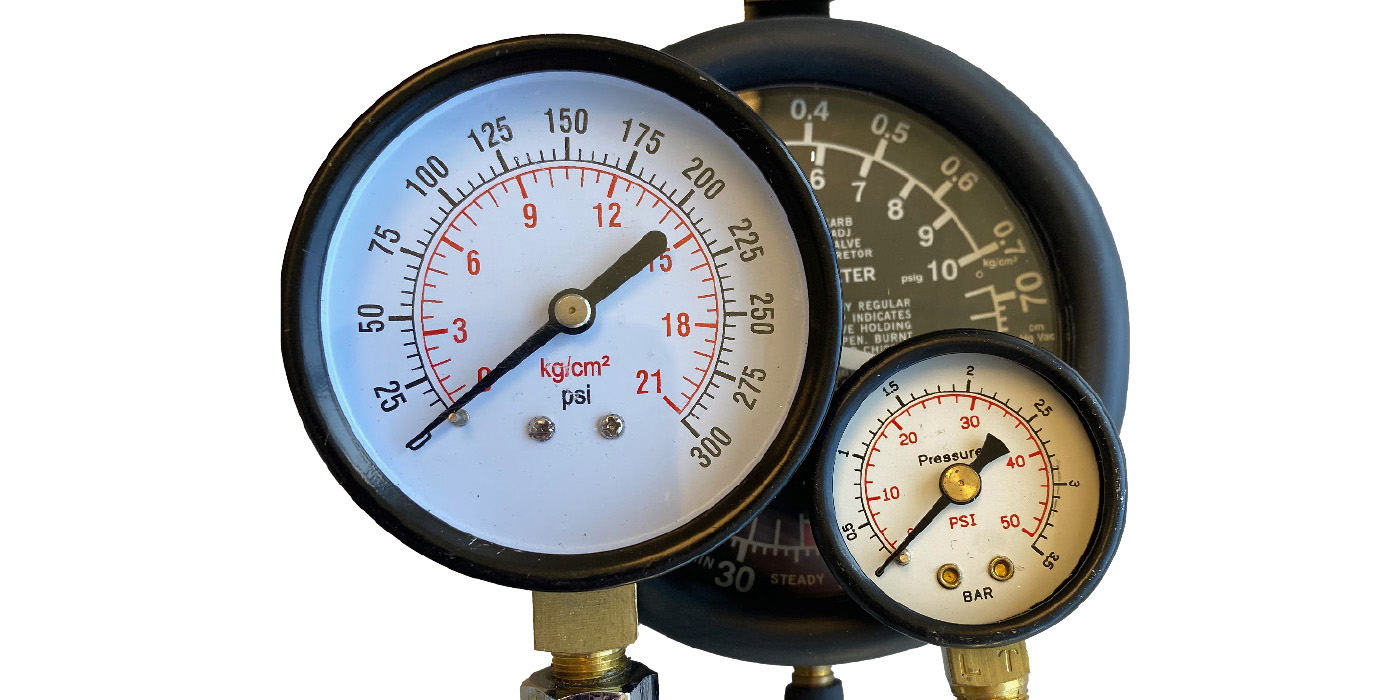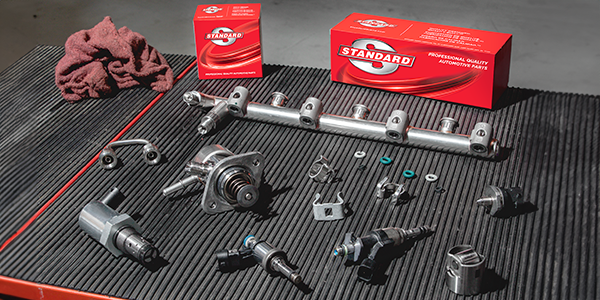and go traffic conditions. Because high underhood heat usually increases electrical and clogging failures in fuel injectors, fuel-injected vehicles driven in metro areas may generally need more maintenance than vehicles driven in rural areas.
We can also generally say that many late 1980s and early 1990s fuel injectors fail more often because of poor design, inferior materials or historically prolonged exposure to poor-quality gasoline. Some fuel injectors of that era tended, for example, to clog quite frequently while others made with faulty materials could develop dangerous external fuel leaks. When such failure patterns are present, replacing fuel injectors in sets is highly recommended.
In addition, many discount gasolines simply fail to keep an injector nozzle clean under adverse driving conditions. Poor quality gasoline allows carbon deposits to collect in intake ports and on intake valves. These carbon deposits absorb fuel during cold start-up and interfere with the injector spray pattern during normal driving. Because most design and fuel quality problems have been addressed during recent years, 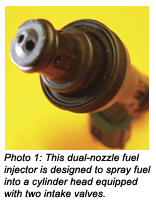 modern import vehicles tend to experience less fuel injector failures than in years past.
modern import vehicles tend to experience less fuel injector failures than in years past.
Fuel injectors are very application specific, both in configuration and in their ability to deliver a specified weight of fuel in a specified length of time. See Photo 1.
A fuel injector is basically a solenoid-operated fuel valve that allows a precisely metered droplet of fuel to be sprayed into the intake port at an exact point in crankshaft rotation. The solenoid is activated when an electric current is passed through the fuel injector windings and pulls the pintle valve off its seat for a few thousandths of a second so fuel can be sprayed into the intake port. A spring returns the pintle valve to its seat and seals off fuel flow when the solenoid is deactivated. An inlet or “basket” screen is installed at the fuel injector inlet to prevent the pintle valve from being held open by microscopic debris transported from the fuel lines, fuel filter or fuel pump inlet screen.
FAILURE SYMPTOMS
A fuel injector is designed to produce a spray pattern that most efficiently distributes fuel into the intake port and into the cylinder itself. Simply put, most fuel injectors lose efficiency because this finely engineered spray pattern is degraded by deposits that collect on the pintle valve and on the injector nozzle. Injector spray patterns that develop inaccurate spray patterns generally cause a loss of fuel economy, increased exhaust emissions and a rough idle condition. Fortunately, today’s gasoline is more highly refined and contains a more sophisticated package of detergents and additives designed to reduce or eliminate fuel deposits in the fuel injector, intake port and on the intake valve.
Although clogged injectors are rare on late-model imports, the general characteristics are a rough idle and a surging sensation as the vehicle accelerates. A similar lean-fuel condition can occur if debris collects on the basket screens on the fuel injectors. Although this condition is equally rare, it can happen if a fuel filter ruptures due to exposure to water condensation in the fuel tank. The only solution is to have the fuel injectors cleaned and rebuilt by a reputable shop or to install new fuel injectors.
Precise fuel pressure control is also essential for correct fuel injection metering. Excessive fuel pressure often causes the engine to run rich, while low fuel pressure has the opposite effect of causing the engine to run lean.
Last, a fuel injector can fail due to a shorted or open winding in the injector solenoid that usually makes the injector inoperative. The symptoms of an inoperative fuel injector are a rough idle, an engine misfire and a loss of power.
VARIOUS CONFIGURATIONS
Fuel injector configurations have evolved in step with the increased data processing capacity of modern engine management computers. Early, less sophisticated engine management systems used a bank-fired strategy in which half of the fuel injectors were fired simultaneously. Some imports also employed a throttle-body fuel injector system in which one or more fuel injectors are suspended above the throttle plate. Last, and most sophisticated, are the sequential, multi-port fuel injection systems in which the injection cycle is timed to the firing order of individual cylinders. Sequential fuel injection produces a smoother-running engine, more power and fuel economy, and less exhaust emissions.
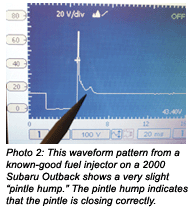 Fuel injectors are produced in two basic electrical configurations: saturated switch and peak-and-hold. In saturated-switch systems, the PCM holds the injector open as long as necessary to create an adequate air/fuel ratio. Peak-and-hold is an electrical configuration in which relatively high amperages are used to raise the injector pintle and relatively low amperages are used to hold the injector open. The peak-and-hold strategy is used most often in throttle-body fuel injector configurations. The negatively switched system is the most common in which the PCM’s injector driver opens the injector by grounding the injector circuit. Positively switched systems are relatively rare, with the PCM’s injector driver opening the injector by supplying current to the injector windings.
Fuel injectors are produced in two basic electrical configurations: saturated switch and peak-and-hold. In saturated-switch systems, the PCM holds the injector open as long as necessary to create an adequate air/fuel ratio. Peak-and-hold is an electrical configuration in which relatively high amperages are used to raise the injector pintle and relatively low amperages are used to hold the injector open. The peak-and-hold strategy is used most often in throttle-body fuel injector configurations. The negatively switched system is the most common in which the PCM’s injector driver opens the injector by grounding the injector circuit. Positively switched systems are relatively rare, with the PCM’s injector driver opening the injector by supplying current to the injector windings.
The engine management system may use several different operating strategies to control air/fuel ratios. The most common strategy is for the PCM to control air/fuel ratio by changing the injector “pulse width” which is measured in thousandths of a second or “milliseconds.” The injector on-time at idle, for example, might increase from 1.75 ms to 2.5 ms to richen the air/fuel ratio. Occasionally, during periods of heavy fuel demand, the PCM might open an injector multiple times during the intake stroke to richen the air/fuel ratio. This is called an “asynchronous” firing of the injectors.
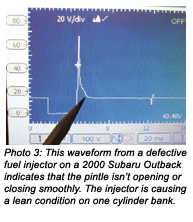 DIAGNOSTIC SUMMARY
DIAGNOSTIC SUMMARY
Due to component access issues and electrical configurations, it’s important for the technician to adopt a diagnostic strategy that’s best suited to the vehicle platform that he’s working on. With that said, a number of different methods can be used to test fuel injectors. The simplest test is to place a stethoscope on the body of the injector to check for a clicking noise produced by pintle valve activity. If the injector pintle is inactive, the PCM’s injector driver should be tested for activity by using a multimeter to display duty cycle or pulse width at the injector connector. The multimeter can also be used to compare injector winding resistance to a published specification or to a known-good injector.
Although multimeters can display pulse width or duty cycle, a lab scope provides a graphic display of injector circuit voltages, pulse widths and even pintle closing patterns. See Photo 2 and Photo 3.
If you’re interested in pursuing lab scope analysis in detail, a number of manuals that cover fuel injector waveforms in detail are available in the aftermarket. If you’re going to use a lab scope to diagnose faulty injectors, it’s also wise to store known-good waveforms in the scope’s database for comparison.
Scan tools may also indicate fuel injector activity by indicating fuel injector operating status on a data screen, storing fuel injector trouble codes, or by retrieving long- and short-term fuel trim numbers from the PCM. Although interpreting fuel trim numbers requires specific training, negative fuel trim numbers generally exceeding 10% indicate that injector pulse width is being decreased to compensate for fuel supplied from an outside source, such as a leaking fuel pressure regulator.
Positive numbers exceeding 10% indicate that the PCM is increasing injector pulse width to compensate for the lack of fuel from clogged fuel injectors or from excess air supplied by an unmetered air source such as a vacuum leak. Unmetered air may also include air leaking into the intake duct on vehicles equipped with air flow sensors. Whatever the case, a scan tool can provide the fastest analysis of a cylinder misfire or poor fuel distribution condition.










